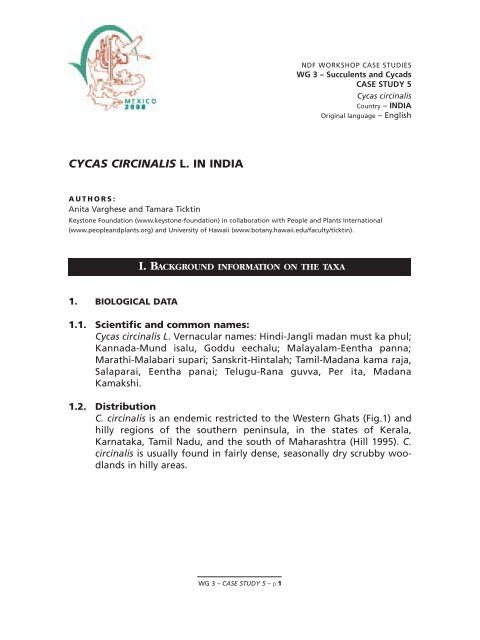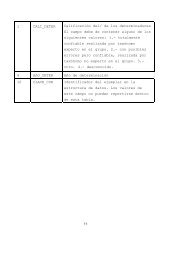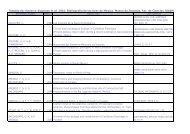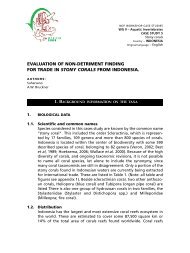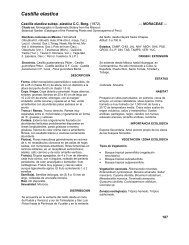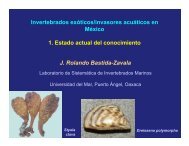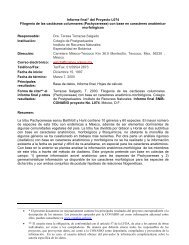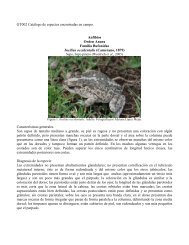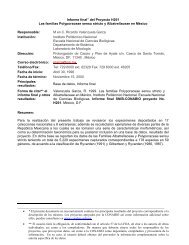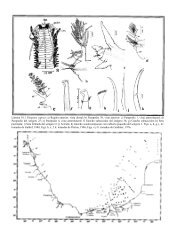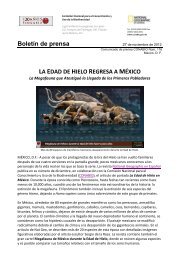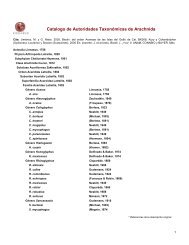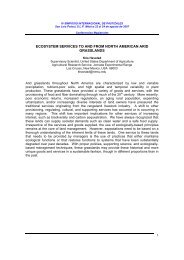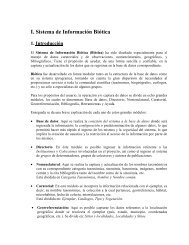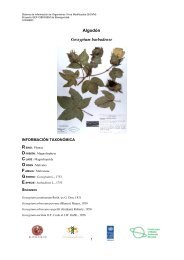CYCAS CIRCINALIS L. IN INDIA - Conabio
CYCAS CIRCINALIS L. IN INDIA - Conabio
CYCAS CIRCINALIS L. IN INDIA - Conabio
You also want an ePaper? Increase the reach of your titles
YUMPU automatically turns print PDFs into web optimized ePapers that Google loves.
<strong>CYCAS</strong> <strong>CIRC<strong>IN</strong>ALIS</strong> L. <strong>IN</strong> <strong>IN</strong>DIA<br />
AUTHORS:<br />
Anita Varghese and Tamara Ticktin<br />
NDF WORKSHOP CASE STUDIES<br />
WG 3 – Succulents and Cycads<br />
CASE STUDY 5<br />
Cycas circinalis<br />
Country – <strong>IN</strong>DIA<br />
Original language – English<br />
Keystone Foundation (www.keystone-foundation) in collaboration with People and Plants International<br />
(www.peopleandplants.org) and University of Hawaii (www.botany.hawaii.edu/faculty/ticktin).<br />
1. BIOLOGICAL DATA<br />
I. BACKGROUND <strong>IN</strong>FORMATION ON THE TAXA<br />
1.1. Scientific and common names:<br />
Cycas circinalis L. Vernacular names: Hindi-Jangli madan must ka phul;<br />
Kannada-Mund isalu, Goddu eechalu; Malayalam-Eentha panna;<br />
Marathi-Malabari supari; Sanskrit-Hintalah; Tamil-Madana kama raja,<br />
Salaparai, Eentha panai; Telugu-Rana guvva, Per ita, Madana<br />
Kamakshi.<br />
1.2. Distribution<br />
C. circinalis is an endemic restricted to the Western Ghats (Fig.1) and<br />
hilly regions of the southern peninsula, in the states of Kerala,<br />
Karnataka, Tamil Nadu, and the south of Maharashtra (Hill 1995). C.<br />
circinalis is usually found in fairly dense, seasonally dry scrubby woodlands<br />
in hilly areas.<br />
WG 3 – CASE STUDY 5 – p.1
Fig.1 – Locations of C.circinalis populations along the Western Ghats, India.<br />
1.3. Biological characteristics<br />
1.3.1. General biological and life history characteristics of the species<br />
Very little is known to date about C. circinalis rates of reproduction,<br />
recruitment, survival,or sex ratios although this information is<br />
currently being gathered. There is some information available on<br />
population structure, impacts of harvest, and rates of leaf production.<br />
In a study of the population structure of C.circinalis in the Nilgiri<br />
Biosphere Reserve (Varghese & Ticktin 2006), it was found that populations<br />
that were harvested only for seeds showed a reverse J curve,<br />
with many individuals in the smaller size classes. This suggests good<br />
levels of regeneration despite seed harvest.<br />
Populations subject to seed and leaf harvest showed a much lower<br />
proportion of seedlings and saplings. This may indicate lower rates of<br />
regeneration as compared to those populations that are not harvested<br />
for their leaves. In addition there were no individuals in the 150-200<br />
cm height size class. The very high rates of leaf harvest (92% of all individuals<br />
> 20 cm high were harvested for their leaves, and 91.3 ± 15 %<br />
of all leaves per tree were harvested) reported above suggest that the<br />
lack of individuals in this size-class could be a result of repeated overharvest<br />
of leaves.<br />
WG 3 – CASE STUDY 5– p.2
The structure of the populations subject to seed, leaf, stem and<br />
male cone harvest consisted almost entirely of individuals in the smallest<br />
size classes. There were no individuals larger than 100 cm in<br />
height. The one exception was one very large individual (> 200 cm<br />
height), but this was found among rocks and highly inaccessible. The<br />
lack of adult individuals points to high levels of stem harvest and<br />
depletion of the adult population.<br />
Fig 2. Population structure of C. circinalis is dependent on harvest type (X 2 = 25.02 p<br />
< 0.001)<br />
a. Seed harvest only, N= 63<br />
b. Seed and leaf harvest, N=33<br />
c. Seed, leaf and stem harvest, N=69.<br />
WG 3 – CASE STUDY 5 – p.3
Rates of leaf production are greatly variable, with larger individuals<br />
producing more leaves per year and individuals in areas of higher precipitation<br />
producing a greater number of leaves per year. Individuals<br />
in mid elevation dry deciduous forests appear to produce a flush of<br />
leaves only once per year, even when harvested, whereas as harvested<br />
individuals in low elevation wetter forests produce leaves throughout<br />
the year.<br />
Branching appears to be a response to heavy leaf harvest. None of<br />
the C. circinalis individuals in populations that were not harvested for<br />
their leaves showed any branching. However, 21.3 % of the individuals<br />
in leaf harvested populations were branched, with the main apical<br />
meristem not producing leaves anymore.<br />
1.3.2. Habitat types:<br />
Found from the coast up to 1200m in the hills. Mostly in the mid elevation<br />
deciduous tracts of the hills, low elevation moist deciduous<br />
forests and along the low elevation riverine vegetation. Also found in<br />
the low elevation teak plantations of Kerala. Appears to grow profusedly<br />
in fire prone areas. The regeneration levels were observed to be<br />
very high. One of the populations along the hills in the Nilgiris were<br />
observed on steep slopes that were prone to land slips.<br />
1.3.3. Role of the species in its ecosystem<br />
BUTTERFLY – Plains cupid butterfly was observed laying eggs on the<br />
immature leaves. The larvae rested at the base of leaf and in a period<br />
of 7-9 days emerged.<br />
SPIDER – One species of Signature Spider was observed weaving its web<br />
on the leaves.<br />
BATS – The juices of the seed coat are ingested by bats and the seed is<br />
dispersed. Rates of regeneration from partially eaten seeds are being<br />
recorded at the nursery.<br />
Indian Sambar Deer-The Sambar deer found throughout Asia feeds on<br />
the acrid tasting fibrous seed with little flesh.<br />
BEES – Dammer bees were observed collecting resinous sap from the<br />
tender leaves of the plant.<br />
Ants – Two species of ants were also observed on Cycas circinalis trees,<br />
collecting the resinous sap from the young unfurling leaves of the<br />
cycad and collecting secretions from the bodies of plains cupid butterfly<br />
larva.<br />
An article with regard to these observations was published in the<br />
newsletter of the Cycad society and can be accessed at<br />
http://www.cycadsg.org/publications/TCS-December2007-Varghese.pdf<br />
WG 3 – CASE STUDY 5– p.4
1.4. Population:<br />
1.4.1. Global Population size:<br />
Table 1 – Populations of Cycas circinalis observed in various locations along the Western<br />
Ghats, India.<br />
Locations Altitude Habitat Estimated<br />
(msl) # of adults<br />
Site 1 Tamil Nadu 1000 Dry deciduous and Savanna woodland<br />
type >300<br />
Site 2 Tamil Nadu 300-500 Riparian forests >300<br />
Site 3 Tamil Nadu 500-800 Dry deciduous, Savanna woodland,<br />
Riparian 500<br />
Site 2 Kerala 300-800 Riparian, Teak plantations,<br />
Moist deciduous >200<br />
Site 3 Kerala Not visited Not visited Not visited<br />
Site 4 Kerala 300-500 Semi evergreen, Moist deciduous,<br />
Teak plantations >300<br />
Site 5 Kerala 300-500 Semi evergreen, Moist deciduous,<br />
Areca plantations >100<br />
Site 4 Tamil Nadu 300-500 Moist deciduous, Teak plantations >200<br />
Site 5 Tamil Nadu Savanna woodland, Teak plantations,<br />
Semi evergreen >200<br />
Site 1 Karnataka Scrub woodland 800<br />
Site 2 Karnataka Scrub woodland 100<br />
1.4.2. Current global population trends:<br />
___increasing __X_decreasing ___stable ___unknown<br />
1.5. Conservation status:<br />
1.5.1. Global conservation status (according to IUCN Red List):<br />
___Critically endangered ___Near Threatened<br />
_X_Endangered ___Least concern<br />
_X_Vulnerable ___Data deficient<br />
1.5.2. National conservation status for the case study country<br />
Cycas circinalis is included in the negative list of exports notified by the<br />
GOI Notification 2 (RE-98) dt. 13-04-1998, 1997-2002 (Ravikumar and<br />
Ved 2000). The plant is also listed as an RET species.<br />
WG 3 – CASE STUDY 5 – p.5
1.5.3. Main threats within the case study country<br />
___No Threats<br />
_x_Habitat Loss/Degradation (human induced)<br />
___Invasive alien species (directly affecting the species)<br />
_x_Harvesting [hunting/gathering]<br />
___Accidental mortality (e.g. Bycatch)<br />
___Persecution (e.g. Pest control)<br />
___Pollution (affecting habitat and/or species)<br />
___Other_______________<br />
___Unknown<br />
2. SPECIES MANAGEMENT WITH<strong>IN</strong> THE COUNTRY FOR WHICH<br />
CASE STUDY IS BE<strong>IN</strong>G PRESENTED<br />
2.1. Management measures<br />
There have been no specific management plans so far put forth for the<br />
management of this species in India.<br />
2.2. Monitoring system<br />
2.2.1. Methods used to monitor harvest<br />
There is no formal monitoring program in place to monitor C. circinalis<br />
harvest throughout its range. However, Keystone Foundation has<br />
established a monitoring program throughout the NBR (including<br />
populations in Tamil Nadu and Kerala states) to monitor harvest. This<br />
involved establishing permanent plots with tagged individuals, and<br />
monthly monitoring of the number of leaves, seeds, cones or stems<br />
harvested. This monitoring was carried out over a period of one year.<br />
2.2.2. Confidence in the use of monitoring<br />
The indigenous communities living closest to the Cycas populations are<br />
being involved in a community monitoring program. For now the program<br />
has started with an interpretation center and a nursery in the<br />
village. The cycas areas are being mapped with people’s participation.<br />
The threats to the populations will be identified and a permanent plot<br />
will be set up in consultation with the harvesters that will be monitored<br />
seasonally. This involves measures of growth, survival, reproduction,<br />
regeneration and a calculation of sex ratios.<br />
2.3. Legal framework and law enforcement:<br />
Listed in Appendix II of the CITES, the species is included in the negative<br />
list of exports notified by the Government of India (Notification 2<br />
(RE-98) dt 13.04. 1998, 1997-2002) (Ravikumar and Ved 2000).<br />
WG 3 – CASE STUDY 5– p.6
3. UTILIZATION AND TRADE FOR RANGE STATE FOR WHICH CASE STUDY<br />
IS BE<strong>IN</strong>G PRESENTED.<br />
3.1. Type of use (origin) and destinations (purposes)<br />
In Kerala and Tamil Nadu indigenous communities harvest mainly the<br />
seed and the young leaves of C. circinalis. These are considered delicacies<br />
and are highly valued. In Tamil Nadu, some villagers relish the<br />
young leaves and steamed seed. Although in Tamil Nadu C. circinalis<br />
seed is harvested for home consumption, in Kerala there is also local<br />
demand for the dried seed. The harvest is heavy here as the harvesters<br />
harvest the seed and sell it after some processing and drying to the<br />
market. The ripe seed is picked (about 25 kg per day) and smoked on<br />
a bamboo mat and then dehusked and dried. Harvesters report that 25<br />
kg of seed would yield only up to two kg of dried seed. In a harvest<br />
village 20 tonnes of fresh seed were collected in 2008.<br />
Harvesters in Tamil Nadu and Kerala harvest the mature leaves of C.<br />
circinalis yearly for making the shelters for special rituals.The mature<br />
leaves are also heavily harvested for the floriculture industry and the<br />
pith from Tamil Nadu is sold in medicinal markets. The price per kg of<br />
dried pith is 20 rupees per kg, if it is milky white. A traditional trader<br />
at Virudhanagar market in Tamil Nadu estimated that from Tamil Nadu<br />
itself about 200-300 tons of the pith is being traded annually. He reported<br />
that the bulk of it was coming from Kerala. The pith is sent to traders<br />
in North India to supply to the herbal medicine industry. An extract<br />
of the pith is used to increase milk production in lactating mothers. He<br />
also reported that the male cone is very important for the production<br />
of a male aphrodisiac and much in demand but difficult to get.<br />
The vendor emphasized that C. circinalis trees were very abundant<br />
about 10 years ago and even found in gardens, but now they are gone<br />
so that pith is now brought from homesteads in Kerala, where the<br />
whole tree is purchased for Rs. 50 -60. When gatherers harvest in the<br />
monsoons it is difficult to dry the produce properly making it brown<br />
in color. When the color is brown the price also drops and the traders<br />
are not able to sell the produce then.<br />
In Kerala, there is a demand for C. circinalis male cones by local farmers.<br />
Most paddy farmers place the cone in the middle of their paddy<br />
fields to drive away a particular insect which attacks the young paddy.<br />
The insect is drawn to the cone because of the smell and leaves the<br />
paddy alone.<br />
WG 3 – CASE STUDY 5 – p.7
Young leaves Yes Yes Food Men and women Men and women Indigenous Indigenous<br />
involved, but involved, young villages villages<br />
mostly older and old people.<br />
people. Harvest Harvest once per<br />
once per year year.<br />
Oct/Nov or mid<br />
April. Hill<br />
communities<br />
Mature leaves Yes Yes Floriculture, For cultural events For religious and Indigenous Indigenous<br />
Thatching and small traders cultural events. villages and villages<br />
who pay up to 2 Men go for local markets<br />
rupees per leaf. collection. Not within the<br />
Mostly men sold. district<br />
involved. Heavy<br />
harvest for market.<br />
Seed Yes Yes Food and Men and women Men and women Indigenous Indigenous<br />
medicine involved, involved, villages villages and<br />
collection rates of collection rates of markets within<br />
about 80% per about 80% per the district due<br />
individual individual. to local<br />
Observed in demand for the<br />
August. dried kernel to<br />
be used<br />
in medicinal<br />
preparations.<br />
Pith Yes Yes Medicine Traders bring their Traders from South Tamil South Tamil<br />
own set of Tamil Nadu come Nadu Nadu<br />
harvesters. to collect the<br />
Clandestine whole plant form<br />
operations with no the homesteads<br />
local people where it grows<br />
involved. High abundantly<br />
harvest rates.<br />
Exhaustion of<br />
populations in<br />
Tamil Nadu<br />
resulted in move to<br />
harvest from<br />
homesteads in<br />
Kerala.<br />
Male cone No Yes Medicine, Local farmers None Local farmers<br />
Insect come in to harvest within the<br />
repellent this for use in their district<br />
paddy fields<br />
WG 3 – CASE STUDY 5– p.8<br />
Tamil Nadu Kerala Tamil Nadu Kerala Tamil Nadu Kerala<br />
Part Harvest Status Use Harvest patterns Demand<br />
harvested<br />
Table 2. Use, harvest patterns and demand for C. circinalis products in Tamils Nadu and Kerala portions of the NBR.
3.2. Harvest:<br />
3.2.1. Harvesting regime<br />
Harvest of young leaves:<br />
The young leaves are collected around October to November and in<br />
mid April. All new leaves from an individual are harvested. This harvest<br />
is only for home consumption and not frequent.<br />
Harvest of seed:<br />
Harvesters report that the seeds are not available for harvest every<br />
year. The seed is collected during the months of July and August in the<br />
Nilambur area and between February and March in the Nilgiris area.<br />
Harvest of mature leaf and pith:<br />
Harvest of mature leaf and pith continues today in the Nilgiri<br />
Biosphere Reserve area. Since the harvest of pith is not permitted by<br />
the Forest Department the harvests happen secretly and are usually<br />
from distant areas. Occasionally the indigenous peoples are paid a perleaf<br />
rate and harvest the mature leaves for the floriculture industry.<br />
There are many small time contractors operating from the base of<br />
the forested slopes of the Nilgiris. One forest contractor reported that<br />
he used to contract harvesters to extract C. circinalis leaves and pith.<br />
One rupee is paid per mature leaf. Leaf is in most demand around<br />
January-February and October to November. He confirmed that pith<br />
harvesters look for the younger trees around 5 ft. tall and it is the pith<br />
found at the lower end of the trunk that is used. Bigger trees have<br />
more fibrous piths and are not favorable.<br />
3.2.2. Harvest management/ control<br />
No permits are issued for collection of Cycas parts.<br />
3.3. Legal and illegal trade levels<br />
Since there is no clarity on the legislation regarding this species, levels<br />
of trade are difficult to assess. The only trade is the illegal trade. 200-<br />
300 tonnes of the dried pith was one of the estimates given by a trader<br />
who was located near the coast in Tamil Nadu. In Kerala a trader<br />
came asking for the male cones and one village harvested 350 kgs of<br />
the cone for him.<br />
A recent study on methods to identify authenticity of raw material<br />
cites the use of dried pith of Cycas sp. as an adulterant for tuber of<br />
Peuraria tuberosa (Devaiah & Venkatasubramanian, 2008).<br />
WG 3 – CASE STUDY 5 – p.9
II. NON-DETRIMENT F<strong>IN</strong>D<strong>IN</strong>G PROCEDURE (NDFS)<br />
II. Non-detrimental Finding procedure (NDFs)<br />
1. IS THE METHODOLOGY USED BASED ON THE IUCN CHECKLIST<br />
FOR NDFS?<br />
__yes _X__no<br />
2. CRITERIA, PARAMETERS AND/OR <strong>IN</strong>DICATORS USED<br />
1)Part of plant that is harvested. Harvest of pith and male cones<br />
appears to be unsustainable. Harvest of seeds and leaves may be<br />
sustainable at some levels depending on at least some of the following:<br />
2)Quantity that is harvested as determined by amount of leaves or<br />
seeds harvested/individual and proportion of individuals in a population<br />
that remain unharvested. Preliminary research (Varghese &<br />
Ticktin 2006) suggests that repeated heavy leaf harvest of C. circinalis<br />
may decrease growth and reproductive output, leading to lowered<br />
regeneration. Very heavy seed harvest could also lead to lowered<br />
regeneration.<br />
3)Time for recovery after harvest and timing of harvest, as determined<br />
by frequency and seasonal timing of harvest of leaves. For example,<br />
the harvest of leaves once a year, soon before they are (naturally)<br />
shed, may have little impact on the individual.<br />
4)Local management for regeneration: Harvest of seeds and/or leaves<br />
can be sustainable in communities that are actively growing Cycas in<br />
nurseries, maintaining their homestead populations and planting<br />
them out to increase populations.<br />
5)Size of population: It would probably not be sustainable to harvest<br />
from very small populations especially if it is an isolated<br />
population.<br />
6)Region harvested: C. circinalis populations have been observed in<br />
many different habitats with very different environmental conditions<br />
and these appear to significantly affect vital rates. For example,<br />
individuals in wetter regions have significantly greater rates of<br />
growth and reproduction than those in drier regions. It is possible<br />
that some populations may withstand higher levels of harvest<br />
because of the more favourable growing conditions.<br />
3. MA<strong>IN</strong> SOURCES OF DATA, <strong>IN</strong>CLUD<strong>IN</strong>G FIELD EVALUATION<br />
OR SAMPL<strong>IN</strong>G METHODOLOGIES AND ANALYSIS USED<br />
1.Part of plant harvested: easily identified.<br />
2.Quantity that is harvested: This would have to be provided by the<br />
seller, along with location of harvest. It could also be verified<br />
WG 3 – CASE STUDY 5– p.10
through field evaluation because both leaf harvest rates (through<br />
evidence of harvested leaves) and the proportion of individuals harvested<br />
can be quantified. Since seeds and leaves are not sold<br />
through organised markets or government mechanisms actual data<br />
on volume could only be gathered through a community based<br />
monitoring where possible. Visits to local markets can also provide<br />
some of this information.<br />
3.Frequency and timing of leaf harvest: This would also have to be<br />
provided by the seller and/or through community-based monitoring<br />
where possible. In the case of protected areas like National Parks<br />
and Sanctuaries collections are technically not permitted.<br />
4.Local management for regeneration: Evidence in community nurseries,<br />
out planted populations in home gardens and/or forests.<br />
5.Population size: Documented through field evaluation.<br />
4. EVALUATION OF DATA QUANTITY AND QUALITY FOR THE ASSESSMENT<br />
1.Plant of part harvested: easily determined accurately.<br />
2.Quantity that is harvested. This can be determined fairly accurately<br />
through field surveys. The limitation is that it is not practical<br />
to do regularly, especially given that many populations are in<br />
remote locations. Community-based monitoring programs can<br />
obtain the information accurately, documenting harvest that<br />
could include both local people and outsiders. The limitation is<br />
number of communities where programs can be established, right<br />
now these programs are just in initiation in a very small number<br />
of communities.<br />
3.Frequency and timing of harvest. This can only be determined accurately<br />
by fairly regular monitoring and so may only be a possibility<br />
in communities with community- monitoring programs. This is<br />
because C. circinalis appear to flush at different times of the year<br />
depending on their location, so it is difficult to identify a time of<br />
year when harvest is optimal across all regions. For the same reason,<br />
annual monitoring cannot accurately determine when/how frequent<br />
harvest was.<br />
4.Local management for regeneration: easily generated by assessment<br />
of nurseries and out plantings<br />
5.Population size: can be determined fairly accurately in the field.<br />
Limitation is localizing the existing populations.<br />
WG 3 – CASE STUDY 5 – p.11
5. MA<strong>IN</strong> PROBLEMS, CHALLENGES OR DIFFICULTIES FOUND ON THE ELA-<br />
BORATION OF NDF<br />
Right now there is not enough data to develop specific guidelines on<br />
harvest practices that are sustainable (especially with respect to quantity<br />
and frequency). We have ongoing studies specifically aimed at<br />
addressing this and expect to have this information within the next<br />
few years.<br />
There is also no clarity on the species in each location, this needs to<br />
be determined and we need to develop a good field guide to the<br />
Cycads of India. When the species itself is not clearly defined then framing<br />
management practises for it become even more tricky.<br />
Another problem is the lack of transparency on the uses of the<br />
cycad parts that find themselves in the trade, especially of pith and<br />
male cones. There is still very little information available on trade<br />
(quantities traded, demand for different plant parts, trade routes etc)<br />
of C. circinalis (and other Cycas species).<br />
There also needs to be a complete ban on destructive harvests that<br />
involve stems and piths.<br />
6. RECOMMENDATIONS<br />
Identify sustainable management practices/plans (quantity, frequency,<br />
timing of harvest) that can be promoted at the community level and<br />
maintained through community-monitoring programs. This will entail<br />
further research on the ecology of this species, its uses/harvest by communities<br />
across its range and their impacts.<br />
Strengthen and further promote the community-based Cycas monitoring<br />
programs that have been initiated.<br />
Improve identification of the cycad species in India, with an easy to<br />
read Field Guide that would help to identify species in the wild and<br />
potentially from parts in markets. This would help to clarify which<br />
populations are actually C. circinalis or other species.<br />
Carry out a survey of the market for Cycas (including both South<br />
and North India). This has not yet been done and could throw more<br />
light on quantity of trade and demand (including timing of demand)<br />
for different parts of the plant.<br />
Develop a Cycas database which could be held with the Biodiversity<br />
Board to disseminate and enhance information on species/populations<br />
in the wild.<br />
Dialogue with the Medicinal Plant Board to identify the threats to<br />
the species and work with them to come up with criteria for procurement<br />
of raw material.<br />
WG 3 – CASE STUDY 5– p.12
REFERENCES:<br />
1.RAVIKUMAR, K. & D.K.Ved. (2000). Illustrated Field Guide-100 Red Listed Medicinal Plants<br />
of conservation concern in Southern India. FRLHT, Bangalore, India<br />
2.HILL KD (1995) The genus Cycas (Cycadaceae) in the Indian region, with notes on the<br />
application and typification of the name Cycas circinalis. Taxon 44: 23–31.<br />
3.HILL, K.D. 2003. Cycas circinalis. In: IUCN 2006. 2006 IUCN Red List of Threatened Species.<br />
Myers, N., Mittermeier, R. A., Mittermeier, C. G., Da Fonseca, G. A.B. & Kent, J. 2000.<br />
Biodiversity hotspots for conservation priorities. Nature 403, 853.<br />
4.VARGHESE, A. & Ticktin, T. 2006. Harvest, Trade, and Conservation of the Endemic Multiuse<br />
Cycad, Cycas circinalis L., in the Nilgiri Biosphere Reserve, South India.<br />
http://cycadsg.org/publications/Cycas-circinalis-case-study.pdf<br />
5.DEVAIAH, K.M. and Venkatasubramanian, P. 2008. Development of SCAR marker for<br />
authentication of Pueraria tuberosa (Roxb. ex. Willd.) DC. Current Science, Vol. 94,<br />
No.10.<br />
WG 3 – CASE STUDY 5 – p.13


